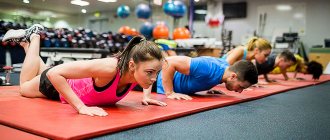Two workouts a day when doing fitness seems at first glance a dubious undertaking. What are they needed for? What's the point? After all, many fitness practitioners only exercise a few times a week to maintain their physical fitness.
In fact, doing two workouts a day can be done for a variety of reasons. Let's name some of them: • Weight loss • Building muscle mass • Preparing for competitions • Lack of time for a full workout
So, although many studies say that exercising several times a week is enough to maintain good physical shape, for some, even one workout per day is not suitable.
Among the numerous studies examining the health effects of fitness training, stand out those that compare the effect of training once a day for one hour with two training sessions of 30 minutes or even several shorter sessions.
As for obesity (fat deposits), blood lipids and psychological mood, it is not yet clear how dividing the training into two or three parts per day will work. The bottom line is that our bodies are much more sensitive to the intensity of exercise than to how long we exercise.
Tough decision
Sooner or later the question arises about whether it is possible to train 2 times a day. Many people unknowingly say a clear “no.” If one workout a day is not enough for a person or he decides to create a second one for himself, then it is worth taking care of balance. In this case, it is worth distributing the loads. 2 workouts a day does not mean that they will be the same and at the same time you will do the same. Many professionals recommend distributing the load of one workout when switching to this regime.
Of course, sports fans who live in the gym for 5-7 hours will not be able to do this. Although you can, for example, add running in the morning, and you will already have “training” twice a day, and even with the correct load.
Professional athletes recommend breaking a regular workout into two, thereby distributing the load so as not to overtrain. But there are fans who can easily switch to two hard workouts a day. In any case, it is recommended to maintain balance. For example, in the morning it is recommended to do a lighter workout, such as running, gymnastics, jumping rope, and the like. In the evening, you can do strength exercises on machines, with dumbbells and a barbell.
How often should you exercise based on your body type?
There are three main body types:
- Ectomorph
- slim and tall, has difficulty gaining muscle mass
- Mesomorph
– well built, developed muscles, increased metabolism and easily responsive muscle cells
- Endomorph
– large body, high fat content, often pear shaped, prone to accumulating body fat
Here's how to train for your body type.
Ectomorphs
The ectomorph type is naturally slender, and they usually do not have such a high percentage of body fat. This means they don't have to spend a lot of time doing cardio.
Cardio itself can be beneficial for cardiovascular health, but ectomorphs don't need to focus on it too much. Choose cardio workouts that you enjoy and do them 2-3 times a week.
Strength training can be included 3-5 times a week
. Since it is difficult for them to gain muscle mass, they can lift weights. Bodyweight work and high-intensity training will also be quite effective.
This, like other types, needs at least 1 day of rest and recovery per week to give the muscles a rest.
Mesomorphs
Mesomorphs can gain and lose weight (muscle and fat) quite easily. Their body responds quickly to physical activity. They have great potential to change their body in amazing ways.
They are advised to do regular cardio exercises to stay lean. It is very useful to take daily walks.
But for mesomorphs, you can also add a few days of high-intensity cardio training, such as running.
Strength training should be done 3 times a week
, and one of them should be high intensity to lose excess fat faster.
Don't forget to rest once a week.
Endomorphs
The endomorph body type tends to have a lot of muscle mass and fat. Their body gains fat quite quickly, but it is very difficult to get rid of it.
However, with proper nutrition and exercise, endomorphs can achieve excellent results.
Walking is preferable to running, especially if you are short, as it can add bulk to your legs. It is recommended to go for a walk 5 times a week.
Strength training can be done 3 times a week
and perform them with your own weight or with light weight for many repetitions.
Try to avoid heavy leg exercises such as squats, lunges, deadlifts and burpees.
Listen to your body. If you need a rest, take it, or you can take an active recovery day a week.
Why do cardio and strength training?
© kyryloshevtsov
If you want to get rid of excess fat, become slimmer and more toned, it is recommended to combine cardio and strength training.
Our body needs different types of exercise - anaerobic and aerobic.
- Anaerobic
Anaerobic exercise is exercise that produces energy without oxygen. This happens by breaking down carbohydrates that our body stores from food. They are usually stored as glycogen in the muscles.
This process occurs naturally, but you need to do the right type of exercise to trigger the anaerobic response.
This includes strength training, high-intensity training, and sprinting.
- Aerobic
During aerobic exercise, our body generates energy using oxygen. It produces energy from fat stores.
Unlike anaerobic exercise, aerobic exercise can be done over a period of time.
These are low intensity workouts such as walking, swimming, running, cycling and others. They can be performed at a speed that you can maintain for a long time.
Proper nutrition
Many people, even those who regularly go to the gym, forget to eat breakfast. This is a very important element of the daily regimen, because it is where the consumption of essential minerals and trace elements begins. So it is recommended to have breakfast without fail.
Those who switch to training 2 times a day should understand that you will have to eat breakfast twice. First breakfast 40 minutes before training. These are light foods - salad or milk - to give energy for training. The second breakfast occurs after training, 30 minutes later. It is recommended to consume cereals, dried fruits and juices.
It is worth remembering that snacks should be present all day. These can be fruits, natural fruit juices or dried fruits. An hour before the second workout, you should eat, but not too much. But a hearty but healthy dinner won’t hurt.
Don't forget about drinking water. To ensure normal functioning of the body, you need to drink a lot of fluid. Professional athletes drink 4-6 liters of water per day. But for an amateur, even less is enough. The calculation is carried out according to the formula: divide a person’s weight by three and multiply by a liter of water. The result is how many liters of liquid you need to drink daily.
A very correct solution would be to consume enough vitamins. In the summer, this includes fruits and berries - currants, raspberries, peaches and the like. In the winter season, when there is not enough fresh fruit, you can eat apples and jams (natural sugar energy drinks that can be consumed even by professional athletes).
The quality of training is more important than the quantity
What you do at the gym or fitness center is more important than how often you exercise. If you go to the gym almost every day, but distribute the loads incorrectly, do not adhere to the exercise technique, or get little rest, you can end up with more harm than good. Many suffer from burnout, overtraining and injury.
Consulting a professional trainer is a great way to create a fitness plan that suits your goals, body type and abilities. It's important to find a workout routine that you can actually maintain over the long term.
Rest between workouts
In order for the muscles to have time to rest and recover between workouts, it is recommended to give them a break of 4-6 hours on one day. It is also worth distributing the load. It is not recommended to train the same muscle group more than once every two days. If on the same day, when you train 2 times a day, you train the same muscle group, then they can become very overtired, but the most dangerous thing is the appearance of backlogs. They are dangerous because a specific muscle cannot be stressed for several weeks. Therefore, distribution of loads is mandatory when performing training 2 times a day.
How long should the training last?
The typical average workout lasts from 45 minutes to an hour. This includes a 10-minute warm-up, 30-40 minutes of core training, and 5-10 minutes of cool-down and stretching.
Don't neglect the first and last points. The purpose of a warm-up is to gently activate and prepare your muscles for the workout, and to get your heart pumping more blood to your muscles with each beat. Cooling down, in turn, helps the body recover, eliminate waste, and reduces the likelihood of sore throat.
Half-hour workouts can also be effective if they include high-intensity exercise. For example, circuit or interval classes differ in that they alternate periods of maximum activity and minimal rest between exercises. This density and concentration of physical activity allows you to simultaneously work out different muscle groups in a minimum period of time.
For example, a circuit workout at FitCurves includes a warm-up, alternating cardio and strength training, as well as a cool-down and stretching. In half an hour of training on hydraulic simulators, created taking into account the anatomical features of the female body, you can lose up to 500 calories.
Overwork
If you feel like your body is overtired, it is recommended to give it a rest for a couple of days. This does not mean that we reduce the training from two times to one. This means that there will be no training for two days at all. If the feeling of overwork has not passed, then it is worth expanding the rest interval to five to seven days. This will allow the body to fully recover and gain the necessary strength.
Active weekend
It is known that you cannot study seven days a week; you must have a day off. Typically, professionals and semi-professionals choose Sunday to relax with family and friends. They also spend this day off quite actively.
The best way to have an active day off is to walk around the city or park, ride a bike (without fanaticism), play ball or bowling. This will help, without particularly straining the muscles, to keep them in good shape, and also to do good gymnastics for the whole body.
Many athletes recommend going to a massage room or sauna on their days off. The best option is the Russian version of the bathhouse. It is here that the muscles can completely relax and recharge with energy.
How much to exercise to improve health and stay fit?
It's no secret that exercise has many health benefits. Sport serves as a preventive measure for various diseases, including:
- cardiovascular diseases
- stroke
- high blood pressure
- diabetes
- obesity
- osteoporosis and fractures
- depression
- colon and breast cancer
- dementia (memory loss), etc.
Keep in mind that baseline body fat levels are different for everyone to begin with. For example, there are ectomorphs (to put it simply, people with a thin physique), it is a priori easier for them to keep themselves in shape than endomorphs (people who tend to be overweight). In addition, the level of healthy fat in the body depends on gender, in men its amount ranges up to 24%, while in women it is up to 31%. The result, in addition, will be influenced by the amount of muscle mass; men by nature have more of it.
Although it all depends on many factors, if your goal is to keep yourself toned and healthy, 3-4 workouts per week is enough.











